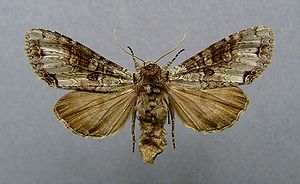Birch leaf owl
| Birch leaf owl | ||||||||||||
|---|---|---|---|---|---|---|---|---|---|---|---|---|

Birch leaf owl ( Polia hepatica ) |
||||||||||||
| Systematics | ||||||||||||
|
||||||||||||
| Scientific name | ||||||||||||
| Polia hepatica | ||||||||||||
| ( Clerck , 1759) |
The birch leaf owl ( Polia hepatica ), also known as blueberry garden owl or berry leaf owl , is a butterfly ( moth ) from the family of owl butterflies (Noctuidae).
features
butterfly
The wingspan of the moth is 39 to 47 millimeters. The silver-gray to bluish-gray basic color of the forewings is typical of the species. Cones, kidney and ring blemishes stand out clearly and are each outlined in dark brown. The inner transverse line is double. The area between the kidney and ring blemishes is usually intensely brown in color and extends to the front edge . Distinctive brown spots can be seen between the wavy line and the outer edge at the inner corner and in the middle. The hind wings show a gray-brown color.
Caterpillar
Young caterpillars are initially reddish in color and change their color to ocher-brown as they develop. A row of dark diamond marks can be seen on the back , which are cut through by the lighter back line. The side lines are blackish in color.
Similar species
The species resembles the gray-colored forms of the Restharrow-leaved owl ( Polia bombycina ) and the shrub-leaf owl ( Polia nebulosa ), which, however, largely lack the distinctive brown drawing elements.
Geographical distribution and habitat
The species is widespread in the temperate climates of Europe and Asia to East Asia, but is absent in the northernmost Fennoscandinavia and in the south of the Iberian Peninsula , Italy and Greece . It is also absent in Japan . The main habitat are birch moors, blueberry forests and humid meadow valleys.
Way of life
The nocturnal moths fly in one generation from late May to early August and like to visit artificial light sources and bait . The caterpillars live from August. They prefer to feed on the leaves of blueberry ( Vaccinium ), blackberry ( Rubus ) or birch species ( Betula ), overwinter and pupate in May of the following year.
Danger
The birch owl is common in Germany, but can be found locally and mostly individually. On the Red List of Threatened Species it is listed in category V (on the warning list).
swell
Individual evidence
- ↑ a b Hermann Hacker, László Ronkay, Márton Hreblay: Hadeninae I . In: Michael Fibiger, David Agassiz, Martin Honey (Eds.): Noctuidae Europaeae . tape 4 . Entomological Press, Sorø 2002, ISBN 87-89430-07-7 (English).
- ↑ Walter Forster , Theodor A. Wohlfahrt : The butterflies of Central Europe. Volume 4: Owls. (Noctuidae). Franckh'sche Verlagshandlung, Stuttgart 1971, ISBN 3-440-03752-5 .
- ^ Günter Ebert (Ed.): The butterflies of Baden-Württemberg . 1st edition. tape 7 . Moth V Noctuidae 3rd part. Ulmer, Stuttgart (Hohenheim) 1998, ISBN 3-8001-3500-0 .
- ↑ Federal Agency for Nature Conservation (Ed.): Red List of Endangered Animals in Germany . Landwirtschaftsverlag, Münster 1998, ISBN 3-89624-110-9 .
literature
- Hermann Hacker, László Ronkay, Márton Hreblay: Hadeninae I . In: Michael Fibiger, David Agassiz, Martin Honey (Eds.): Noctuidae Europaeae . tape 4 . Entomological Press, Sorø 2002, ISBN 87-89430-07-7 (English).
- Günter Ebert (Ed.): The butterflies of Baden-Württemberg . 1st edition. tape 7 . Moth V Noctuidae 3rd part. Ulmer, Stuttgart (Hohenheim) 1998, ISBN 3-8001-3500-0 .
Web links
- Lepiforum eV photo
- www.schmetterlinge-deutschlands.de Endangerment
- Polia hepatica in Fauna Europaea